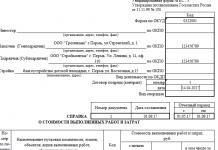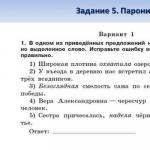M.G. Moshkovich, lawyer
Rospotrebnadzor told how to draw up price tags in retail trade
May 7 Information from Rospotrebnadzor dated 05/07/2016At the end of last year, changes were made to the rules for issuing price tags for goods sold in retail trade. As before, price tags must be uniform and clearly designed; they must indicate the name of the product and its grade (if available), price per weight or unit of product. At the same time, retail received some freedom in choosing the order of registration. In particular, you can use not only paper price tags, but also electronic displays, slates, stands and other information media that are visually accessible to buyers. (hereinafter referred to as the Rules).
WE WARN THE MANAGER
For incorrect registration of price tags may be punished in amounts Art. 14.15 Code of Administrative Offenses of the Russian Federation:
- from 1 to 3 thousand rubles. - director or individual entrepreneur;
- from 10 to 30 thousand rubles. - company.
The period for bringing to responsibility is 1 year from the date of commission of the violation Part 1 Art. 4.5 Code of Administrative Offenses of the Russian Federation.
Issuing price tags is a serious matter; violations can result in an administrative fine.
Therefore, companies and individual entrepreneurs have many questions: how should the amendments be interpreted? Rospotrebnadzor decided to come to their aid by issuing the following clarifications.
The procedure for providing information about the price can be established by the seller for each individual case, taking into account the specifics of the display, placement of goods on the sales floor, the conditions of their sale, etc. The main thing is that the consumer can obtain reliable information about the price of the goods and information in an accessible and visual form. terms of sale.
If, during a sale or other marketing campaign, dissimilar goods laid out together (in a basket, on a cart, etc.) are sold at the same price, then you can issue one common price tag for them.
When selling light industrial goods (for example, clothing, linen, shoes, hats), it is permissible to indicate the price either on labels or on price tags. There is no need to duplicate it here and there.
The following are no longer required on the price tag:
- signature of the financially responsible person;
- organization seal;
- date of issue of the price tag.
But if these details (all or part) are present on your price tags, this is not a violation, but simply an indication of additional information. You can put them further if you want. The seal is no longer needed on the price list, which is drawn up for carrying out retail trade and clause 19 of the Rules, approved. Government Decree No. 55 dated January 19, 1998 (hereinafter referred to as the Rules).
But for indicating on the price tags simultaneously the prices with a card (discount) in large print and the prices without a card (higher) in small print, they can be punished, since such design misleads the buyer. This no longer follows from the explanations of Rospotrebnadzor, but from the Resolution of the Supreme Court adopted last year
Are there any peculiarities in the design of price tags in stores in 2018? How to arrange price tags correctly? What should you consider when applying? What are the requirements for price tags for goods, according to regulations? We'll tell you more in our article.
What laws govern the design of price tags for goods?

- The RPO Law gives the right to sell goods only with a correctly issued price tag;
- Law on Consumer Rights Part 3 Article 15: the seller is obliged to set the cost of the goods;
- Order No. 833, para. 2 states that the cost of goods and products is indicated on labels;
- Clause 19 of the Sales Rules indicates that the seller’s responsibilities include ensuring uniform design of price tags with the name of the product, its variety, cost per unit or weight, signed by the person responsible and dated;
- The Consumer Rights Law contains in paragraph. 1 clause 13 of Instruction No. 2 and para. 2 hours 3 tbsp. 15 rules for designing price tags.
How to write a price tag correctly?
The price tag must be issued before the goods arrive. Price tags for goods can be either printed or handwritten. The retail price of goods is applied in any way: marking, stamp, label gun or ink. It is prohibited to fill out price tags with a pencil. It is necessary to draw up price tags carefully and clearly. The language on price tags complies with current language legislation.
Each type (piece, weight, packaged) and group of goods (non-food/food) has its own design rules. Let's highlight the main ones.
Pricing for food products:
- Weighted goods contain information: “name”, price per 100 grams or kilograms;
- Products and drinks on tap - name, cost per unit of weight or container, type;
- Piece goods: name, grade, capacity or weight, price per piece;
- Prepackaged goods contain information on the price tags about the name, variety, cost of a kilogram or one hundred grams, weight and cost of a packaging unit.

A program for automating the work of a Business.Ru store helps to easily create price tags for goods that comply with the new legislation. You will also have the opportunity to manage prices without leaving your home, thanks to storing all information in the cloud.
Price lists for non-food products:
- Products whose price depends on the grade contain information about the grade, price per kg and meter, unit or piece;
- If the cost of a product does not depend on the type, then on the price tag we put information about the cost per packaging unit and piece, price per meter or kg;
- For piece goods, the price tag must indicate the name, capacity or weight, unit or piece cost.


Rules for registration of price tags: product details
- Name of product
The name on the product is: “Circus Candy”, “Chocolate Carousel”. - Variety
There are no special rules, the main thing is to correctly indicate the type of product being sold. - Unit volume or weight
We indicate the weight of the product: 1000 ml, 1 kg and 1 t, 1 m, 100 g, 1 piece, 1 l. - Cost of one unit
According to the Law on Consumer Rights, Article 15, the price is indicated for one package of goods. When the product is without packaging, for its unit of measurement. The seller sets the cost of each product unit or category of goods.
How to write a price tag correctly? The price of the product is indicated taking into account all taxes and non-tax payments. It is not necessary to allocate VAT separately. The price tag is signed by the responsible person, the date is indicated, and certified with a seal.
How to properly design a price tag for a retail store
When printing is not needed:
- The seal does not need to be affixed to consumer cooperation enterprises located outside the city;
- Enterprises may not affix a stamp in case of export trade. But in this case there must be an invoice;
- Printing is also not needed by retail businesses that identify products using barcodes. In this case, a price list with the signature of the responsible employee, stamp and date must be located in the sales areas.
How to correctly design a price tag on the other side? There is no ban on placement. The rules state that access to the reverse side should not be difficult.
Important! According to the Consumer Rights Law, the seller is obliged, at the buyer’s request, to present documents that confirm the cost of the goods indicated on the price tag.
How to write a price tag correctly? (Tsvetaeva V.)
Article posted date: 04/27/2016
Entrepreneurs who are engaged in retail trade are faced with the need to issue price tags for the goods they sell. At first glance, this procedure seems simple and straightforward. However, practice shows that sellers often issue price tags in violation of the law. We will tell you what you should pay attention to when indicating the price of a product and what liability a businessman faces if he violates legal requirements.
Let us say right away that for violations when issuing price tags, an entrepreneur may face a fine of one to three thousand rubles (note to Article 2.4, Article 14.15 of the Code of Administrative Offenses of the Russian Federation). The authorities of Rospotrebnadzor are held accountable for this violation (Part 1 of Article 23.49 of the Code of Administrative Offenses of the Russian Federation).
Price list according to GOST
The definition of the price tag is given in GOST R 51303-2013 "National Standard of the Russian Federation. Trade. Terms and Definitions" (approved by Order of Rosstandart dated August 28, 2013 N 582-st). In accordance with clause 182 of this document, the price tag is considered to be a paper or other medium, a means of conveying information about the product to the buyer. The price tag accompanies samples of goods displayed on counters, showcases, etc. According to GOST, the price tag must contain:
- information about the name, grade (if available), price per weight or unit (piece, meter, etc.) of the product;
- date of registration of the price tag;
- signature of the financially responsible person or seal of the trade organization.
Rules for selling goods: new trends
Until recently, similar requirements for the price tag were contained in clause 19 of the Rules for the sale of certain types of goods (approved by Decree of the Government of the Russian Federation of January 19, 1998 N 55, hereinafter referred to as the Rules). However, on January 2, 2016, Decree of the Government of the Russian Federation dated December 23, 2015 N 1406 “On amendments to the Rules for the sale of certain types of goods” came into force. This document excluded from the Rules the seller’s obligation to indicate the date the price tag was issued, as well as to affix a signature or seal.
Thus, at present, paragraph 19 of the Rules requires that price tags indicate only the name of the product, its grade (if available) and, of course, the price per weight or unit of product. In our opinion, this information on the price tag will be quite enough.
Another innovation of the Rules is the possibility of issuing price tags not only on paper, but also on any other visually accessible media for buyers. This could be, for example, a digital display, a stand, or even a slate board.
Multiple prices for one product
You can often find price tags on the shelves indicating different prices for the same product. The lower price is indicated in large print and is reserved for certain categories of buyers, such as wholesalers or people with a discount card. In this way, entrepreneurs try to attract more customers. But is this little trick legal? The courts do not give a clear answer to this question.
Thus, the Supreme Court of the Russian Federation in Resolution No. 307-AD15-7060 dated July 10, 2015 in case No. A56-30892/2014 established that two prices were indicated on the price tags of goods sold: the price with a card (in a larger font) and the price without a card. Such price tags, according to the court, do not meet the requirements of uniformity and clarity, thereby misleading consumers.
Surprisingly, in some cases sellers manage to set three prices for goods at once.
Arbitrage practice. The Rospotrebnadzor department received a complaint from a citizen about a violation of consumer rights. The essence of the violation, in his opinion, was the placement of different prices on the price tag of the same product, indicating the information “without a Lenta card,” “with a Lenta card,” and “on promotion.” According to the citizen, this is misleading regarding the actual value of the goods.
The complaint became the basis for an inspection of the store, based on the results of which a protocol on administrative violation was drawn up, and later a resolution on prosecution under Art. 14.15 Code of Administrative Offenses of the Russian Federation. An appeal against this decision in court was unsuccessful.
The arbitrators recalled that, in accordance with clause 18 of the Rules, the prices of goods must be the same for all buyers (which does not call into question the possibility of the seller providing discounts on the goods he sells, including through the distribution of plastic cards). In addition, clause 19 of the Rules requires that price tags for goods sold be drawn up uniformly and clearly (Resolution of the Thirteenth Arbitration Court of Appeal dated November 8, 2012 in case No. A56-29586/2012).
However, in some cases the courts express the opposite point of view. For example, the same Supreme Court of the Russian Federation, by Ruling No. 307-KG14-5693 dated December 25, 2014, refused to accept for review the Resolution of the Arbitration Court of the North-Western District dated September 9, 2014 No. F07-7284/2014 in case No. A56-73200/2013. And in this Resolution, the arbitrators came to the conclusion that indicating on the price tag the cost of goods for ordinary and regular customers does not violate consumer rights.
In general, if a businessman is not ready to argue with inspectors from Rospotrebnadzor, then it is better to indicate one price on the price tags, and information about discounts for various categories of buyers can be placed in a separate, prominent place.
Several products at one price
The opposite situation often occurs when the seller indicates the price for several goods at once. Such a solution, on the one hand, facilitates the choice of a buyer who does not need to compare prices for individual goods, but on the other hand, it may raise questions from Rospotrebnadzor.
Fortunately, the courts have recognized such price indications as permissible. They believe that such registration complies with the requirements of clause 19 of the Rules (Resolution of the Federal Antimonopoly Service of the Central District dated June 16, 2009 in case No. A62-961/2009). The main thing is that such a single price tag contains all the necessary information about each product.
Price list instead of price tags
In accordance with clause 19 of the Rules, during retail trading, the seller’s representative is required to have a price list that replaces price tags. It must be certified by the signature of the person responsible for its execution and contain the name and price of goods, as well as services provided with the consent of the buyer.
But you cannot issue a price list instead of price tags in a regular store.
Arbitrage practice. Rospotrebnadzor inspected the shoe store. The inspectors found that the sale was carried out using the self-service method. Shoe samples are displayed in the sales area without boxes on open shelves. Buyers independently choose the pair of shoes they need to try on and purchase.
Some samples have stickers on the soles with numbers on them. What they mean is a mystery.
Near the cash register area there is a consolidated book of price tags, which is a price list. However, there is no information about the availability of such a book for consumers in stores.
According to Rospotrebnadzor employees, the store violated clause 11 of the Rules, according to which the seller is obliged to provide the buyer with the necessary and reliable information about the goods and their manufacturers in a clear and accessible form. In addition, there is a violation of clause 19 of the Rules, since the seller did not ensure the availability of uniform and clearly written price tags with all the necessary information.
The court agreed with the inspectors (Resolution of the Ninth Arbitration Court of Appeal dated August 26, 2013 No. 09AP-25787/2013-AK in case No. A40-12889/13).
Similarly, in another case, inspectors found that price tags were issued in the form of stickers containing only the price of the goods. The rest of the information is given in the summary book with price tags located at the checkout. Rospotrebnadzor, and after it the court, came to the conclusion that the store violated the requirements of clause 19 of the Rules (Resolution of the Thirteenth Arbitration Court of Appeal dated May 24, 2012 in case No. A56-55522/2011).
Price in conventional units
In conditions of the economic crisis and the unpredictable exchange rate of the ruble, many sellers are tempted to fix prices in conventional units or in hard foreign currency (dollars or euros). Moreover, the law allows for the possibility of setting prices in yuan. e. or in foreign currency (Article 317 of the Civil Code of the Russian Federation). But this rule applies to contracts between companies and (or) merchants. And in relations with consumers, the price must be indicated exclusively in rubles and nothing else (paragraph 4, paragraph 2, article 10 of the Law of the Russian Federation of 02/07/1992 N 2300-1 “On the Protection of Consumer Rights”).
It turns out that a businessman who indicates price tags other than rubles is breaking the law. He may be fined under Part 1 of Art. 14.8 of the Code of Administrative Offenses of the Russian Federation in the amount of 500 to 1000 rubles.
Price with or without VAT?
In some large chain supermarkets you can find prices with the amount of VAT highlighted or an indication that the price is indicated without this tax. Questions arise: how legal is such a practice or can it be adopted? The answer depends on who the buyer of the product is.
If we are talking about the retail sale of goods to the public, then VAT must be included in the price. At the same time, the amount of tax is not indicated on product labels, price tags, receipts and other documents issued to the buyer (clause 6 of Article 168 of the Tax Code of the Russian Federation).
Price tags without VAT are usually used when goods are sold to legal entities and (or) entrepreneurs.
The general requirements for the design of price tags for goods are established by clause 19 of the “Rules for the sale of certain types of goods” approved by Decree of the Government of the Russian Federation dated January 19, 1998 No. 55 (as amended on December 23, 2016).
According to this document, the Seller is obliged to ensure the availability of uniform and clearly written price tags for the goods sold, indicating the name of the goods, grade (if available), price per weight or unit of goods. It is allowed to issue price tags on paper or other information media visually accessible to buyers, including with electronic display of information, using slate boards, stands, and light displays.
Violation of the rules for the sale of certain types of goods - entails a warning or the imposition of an administrative fine on citizens in the amount of three hundred to one thousand five hundred rubles; for officials - from one thousand to three thousand rubles; for legal entities - from ten thousand to thirty thousand rubles (Article 14.15.)
Another document that should be used when issuing price tags in a pharmacy can be called Federal Law No. 2300-1 “On the Protection of Consumer Rights.” Federal law establishes the need to provide reliable information about medicines.
On March 1, 2017, Order No. 647n of the Ministry of Health of the Russian Federation “Rules of Good Pharmacy Practice for Medicinal Products for Medical Use” came into force, which regulates Rules for issuing price tags for medicines .
According to paragraph 35 of these rules, the price tag for the medicinal product must be placed in a convenient place for viewing, indicating the name, dosage, number of doses in the package, country of origin, expiration date (if available).
From the text of paragraph 35 of the NAP Rules, we can conclude that the requirement to place price tags applies only to over-the-counter drugs .
"... 35. Information about over-the-counter medications can be placed on the shelf in the form of a poster, wobbler and other information media in order to provide the buyer with the opportunity to make an informed choice of a pharmacy product, obtain information about the manufacturer, the method of its use and in order to preserve the appearance of the product. Also, in a convenient place for viewing, a price tag should be placed indicating the name, dosage, number of doses in the package, country of origin, expiration date (if available)..."
This requirement does not contradict the norms of the above “Rules for the sale of certain types of goods”, but only complements it.
Try all the features of the ECAM platform for free
Read also
Privacy agreement
and processing of personal data
1. General Provisions
1.1. This agreement on confidentiality and processing of personal data (hereinafter referred to as the Agreement) was accepted freely and of its own free will, and applies to all information that Insales Rus LLC and/or its affiliates, including all persons included in the same group with LLC "Insails Rus" (including LLC "EKAM Service") can obtain information about the User while using any of the sites, services, services, computer programs, products or services of LLC "Insails Rus" (hereinafter referred to as the Services) and in during the execution of Insales Rus LLC any agreements and contracts with the User. The User's consent to the Agreement, expressed by him within the framework of relations with one of the listed persons, applies to all other listed persons.
1.2.Use of the Services means the User agrees with this Agreement and the terms and conditions specified therein; in case of disagreement with these terms, the User must refrain from using the Services.
"Insales"- Limited Liability Company "Insails Rus", OGRN 1117746506514, INN 7714843760, KPP 771401001, registered at the address: 125319, Moscow, Akademika Ilyushina St., 4, building 1, office 11 (hereinafter referred to as "Insails" ), on the one hand, and
"User" -
or an individual who has legal capacity and is recognized as a participant in civil legal relations in accordance with the legislation of the Russian Federation;
or a legal entity registered in accordance with the laws of the state of which such person is a resident;
or an individual entrepreneur registered in accordance with the laws of the state of which such a person is a resident;
which has accepted the terms of this Agreement.
1.4. For the purposes of this Agreement, the Parties have determined that confidential information is information of any nature (production, technical, economic, organizational and others), including the results of intellectual activity, as well as information about the methods of carrying out professional activities (including, but not limited to: information about products, works and services; information about technologies and research activities; data about technical systems and equipment, including software elements; business forecasts and information about proposed purchases; requirements and specifications of specific partners and potential partners; information, related to intellectual property, as well as plans and technologies related to all of the above) communicated by one party to the other in written and/or electronic form, expressly designated by the Party as its confidential information.
1.5. The purpose of this Agreement is to protect confidential information that the Parties will exchange during negotiations, concluding contracts and fulfilling obligations, as well as any other interaction (including, but not limited to, consulting, requesting and providing information, and performing other instructions).
2. Responsibilities of the Parties
2.1. The Parties agree to keep secret all confidential information received by one Party from the other Party during the interaction of the Parties, not to disclose, divulge, make public or otherwise provide such information to any third party without the prior written permission of the other Party, with the exception of cases specified in the current legislation, when the provision of such information is the responsibility of the Parties.
2.2.Each Party will take all necessary measures to protect confidential information using at least the same measures that the Party uses to protect its own confidential information. Access to confidential information is provided only to those employees of each Party who reasonably need it to perform their official duties under this Agreement.
2.3. The obligation to keep confidential information secret is valid within the validity period of this Agreement, the license agreement for computer programs dated December 1, 2016, the agreement to join the license agreement for computer programs, agency and other agreements and for five years after termination their actions, unless otherwise separately agreed by the Parties.
(a) if the information provided has become publicly available without a violation of the obligations of one of the Parties;
(b) if the information provided became known to a Party as a result of its own research, systematic observations or other activities carried out without the use of confidential information received from the other Party;
(c) if the information provided is lawfully received from a third party without an obligation to keep it secret until it is provided by one of the Parties;
(d) if the information is provided at the written request of a government agency, other government agency, or local government body in order to perform their functions and its disclosure to these bodies is mandatory for the Party. In this case, the Party must immediately notify the other Party of the received request;
(e) if the information is provided to a third party with the consent of the Party about which the information is transferred.
2.5.Insales does not verify the accuracy of the information provided by the User and does not have the ability to assess his legal capacity.
2.6. The information that the User provides to Insales when registering in the Services is not personal data, as defined in Federal Law of the Russian Federation No. 152-FZ of July 27, 2006. “About personal data.”
2.7.Insales has the right to make changes to this Agreement. When changes are made to the current edition, the date of the last update is indicated. The new version of the Agreement comes into force from the moment it is posted, unless otherwise provided by the new version of the Agreement.
2.8. By accepting this Agreement, the User understands and agrees that Insales may send the User personalized messages and information (including, but not limited to) to improve the quality of the Services, to develop new products, to create and send personal offers to the User, to inform the User about changes in Tariff plans and updates, to send the User marketing materials on the subject of the Services, to protect the Services and Users and for other purposes.
The user has the right to refuse to receive the above information by notifying in writing to the email address Insales -.
2.9. By accepting this Agreement, the User understands and agrees that Insales Services may use cookies, counters, and other technologies to ensure the functionality of the Services in general or their individual functions in particular, and the User has no claims against Insales in connection with this.
2.10. The user understands that the equipment and software used by him to visit sites on the Internet may have the function of prohibiting operations with cookies (for any sites or for certain sites), as well as deleting previously received cookies.
Insales has the right to establish that the provision of a certain Service is possible only on the condition that the acceptance and receipt of cookies is permitted by the User.
2.11. The user is independently responsible for the security of the means he has chosen to access his account, and also independently ensures their confidentiality. The User is solely responsible for all actions (as well as their consequences) within or using the Services under the User’s account, including cases of voluntary transfer by the User of data to access the User’s account to third parties under any conditions (including under contracts or agreements) . In this case, all actions within or using the Services under the User’s account are considered to be carried out by the User himself, except in cases where the User notified Insales of unauthorized access to the Services using the User’s account and/or of any violation (suspicion of violation) of the confidentiality of his means of accessing your account.
2.12. The User is obliged to immediately notify Insales of any case of unauthorized (not authorized by the User) access to the Services using the User’s account and/or of any violation (suspicion of violation) of the confidentiality of their means of access to the account. For security purposes, the User is obliged to independently safely shut down work under his account at the end of each session of working with the Services. Insales is not responsible for possible loss or damage to data, as well as other consequences of any nature that may occur due to the User’s violation of the provisions of this part of the Agreement.
3. Responsibility of the Parties
3.1. The Party that has violated the obligations stipulated by the Agreement regarding the protection of confidential information transferred under the Agreement is obliged, at the request of the injured Party, to compensate for the actual damage caused by such violation of the terms of the Agreement in accordance with the current legislation of the Russian Federation.
3.2. Compensation for damage does not terminate the obligations of the violating Party to properly fulfill its obligations under the Agreement.
4.Other provisions
4.1. All notices, requests, demands and other correspondence under this Agreement, including those including confidential information, must be in writing and delivered personally or via courier, or sent by email to the addresses specified in the license agreement for computer programs dated 12/01/2016, the agreement of accession to the license agreement for computer programs and in this Agreement or other addresses that may subsequently be specified in writing by the Party.
4.2. If one or more provisions (conditions) of this Agreement are or become invalid, then this cannot serve as a reason for termination of the other provisions (conditions).
4.3. This Agreement and the relationship between the User and Insales arising in connection with the application of the Agreement are subject to the law of the Russian Federation.
4.3. The User has the right to send all suggestions or questions regarding this Agreement to the Insales User Support Service or to the postal address: 107078, Moscow, st. Novoryazanskaya, 18, building 11-12 BC “Stendhal” LLC “Insales Rus”.
Publication date: 12/01/2016
Full name in Russian:
Limited Liability Company "Insales Rus"
Abbreviated name in Russian:
LLC "Insales Rus"
Name in English:
InSales Rus Limited Liability Company (InSales Rus LLC)
Legal address:
125319, Moscow, st. Akademika Ilyushina, 4, building 1, office 11
Mailing address:
107078, Moscow, st. Novoryazanskaya, 18, building 11-12, BC “Stendhal”
INN: 7714843760 Checkpoint: 771401001
Bank details:


















